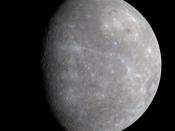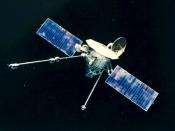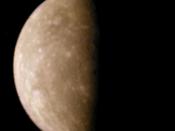MERCURY
In Roman mythology Mercury is messenger of the gods, and son of the god Jupiter. Mercury is the planet closest to the sun. Its distance from the sun is approximately 58 million km (about 36 million miles); its diameter is 4875 km (3030 miles); its volume and mass are about : that of the earth; and its density is approximately equal to that of the earth. Mercury revolves about the sun in a period of 88 days. Radar observations of the planet show that its period of rotation is 58.7 days, or two-thirds of its period of revolution. The planet, therefore, rotates one and a half times during each revolution. Because its surface consists of rough, porous, dark-colored rock, Mercury is a poor reflector of sunlight. Mercury is the second smallest planet in the solar system and it has no known moons.
Spectroscopic studies indicate that only an extremely thin atmosphere, containing sodium and potassium.
Collisions with other protoplanets early in the history of the solar system may have stripped away lighter materials, thereby accounting for Mercury's great density. The force of gravity on the planet's surface is about one-third of that on earth's surface.
The Mariner 10 spacecraft passed Mercury twice in 1974 and once in 1975. It sent back pictures of a moonlike, crater-pocked surface and reported temperatures to be about 430ð C (about 810ð F) on the sunlit side and about -180ð C (about -290ð F) on the dark side. It's atmosphere consists of sodium, helium, hydrogen, and oxygen. Mariner 10 also detected a magnetic field 1 percent that of the earth. Unlike that of the earth's moon, the surface of Mercury is criss-crossed by long escarpments, dating perhaps from the period of contraction the planet experienced as it cooled some time early in its...


